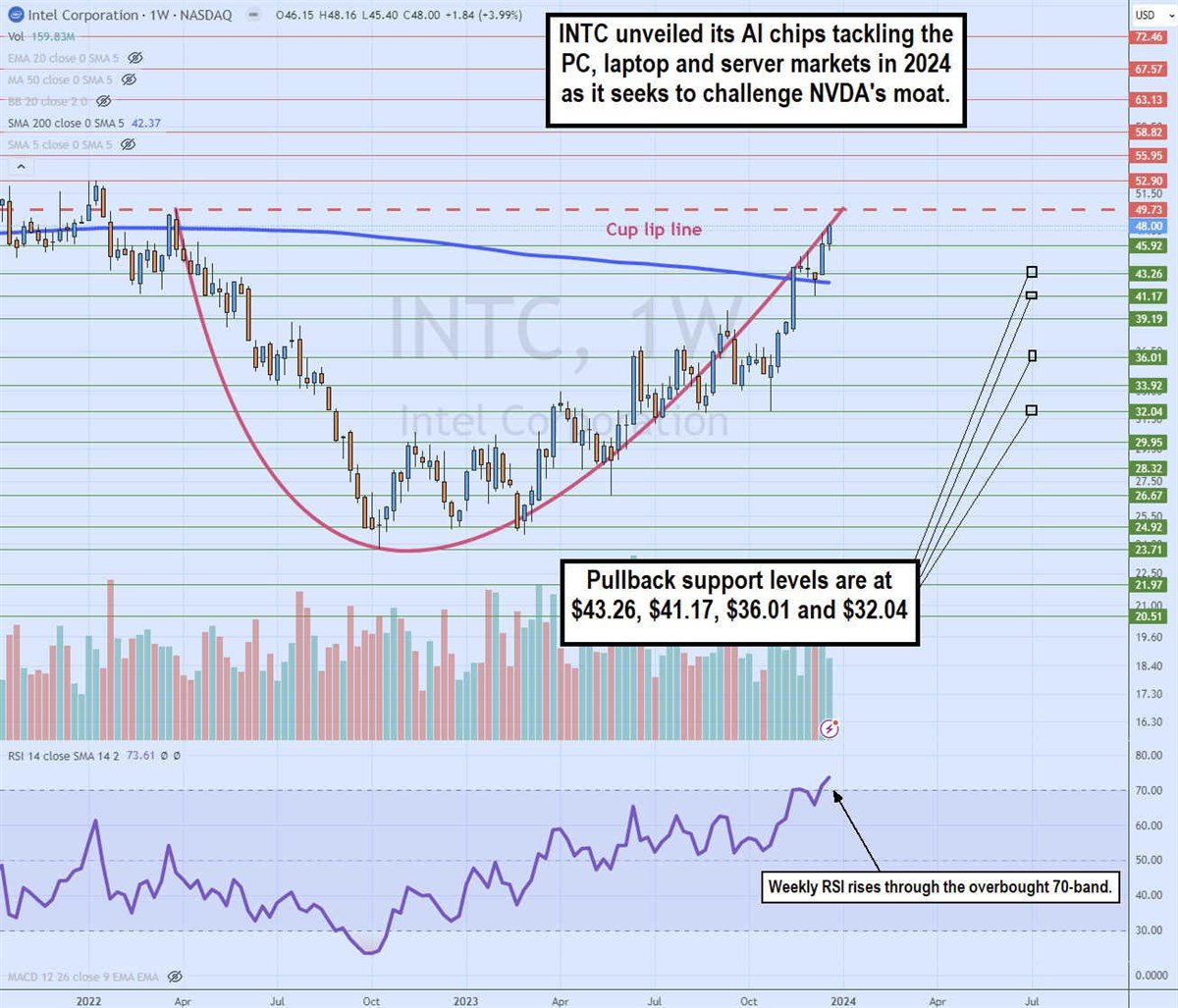While the artificial intelligence (AI) computing market has been dominated by Nvidia Co. NASDAQ: NVDA, new challengers are invading their turf with their own AI accelerators. 2024 should prove to be epic in terms of the evolution and adoption of AI technology in the computer and technology sector. Applied Micro Devices Inc. NYSE: AMD had thrown its hat into the ring with its MI300X to challenge fellow GPU maker Nvidia.
However, a familiar brand name has also thrown its hat into the ring with the indication that its latest AI chip, Gaudi3, is superior to the sold-out Nvidia H100 chip. Semiconductor manufacturing giant Intel Co. NASDAQ: INTC has set its sights on the AI PC era, launching its AI chips developed for PCs, laptops, and servers. It’s specifically targeting Nvidia’s compute unified device architecture (CUDA) software platform.
Core Ultra to power the AI PC era
At its AI Everywhere conference, Intel embraced the AI revolution and promoted the launch of the next PC ecosystem evolution around AI, coining the New Age of AI PC in 2024. CEO Gelsinger likened it to a "Centrino moment ."Centrino was the chip that helped to create wi-fi. Centrino helped to connect and drive wi-fi into coffee shops, businesses, and hotel rooms. AI PC will drive the next generation of the PC experience.
AI PC is expected to grow to 80% of the PC market by 2028. Intel is committed to shipping over 100 million processors with dedicated AI. It expects one processor to handle every segment, from graphics to AI to battery. Intel announced the launch of its Core Ultra processors to drive the AI PC era, which has an Arc GPU enabling gaming and an on-chip AI accelerator or neural processing unit (NPU) for AI tasks. The chip will use 79% less power than competitors on key metrics and up to 3X performance. Intel proclaims the Core Ultra is the largest architecture change for PCs and ultra-thin laptops in 40 years.
Data Center CPU for AI
Intel also launched the Xeon 5th generation processors for data centers, which operate at 21% average performance improvement and 42% performance improvement on AI Inference over the previous generation. AI accelerators were built into each of the processor's 64 cores. The 5th generation Xeon enables enterprises to run the latest generative AI models like GPT-J, Dolly, and Lama 2. It can fine-tune large language models (LLM) like the 1.5 billion parameter bio-GPT model in several minutes.
In the cloud, it will operate natural language processing (NLP) applications 23% faster, 50% faster 5G user plane functions in the network, and 24% faster objection classifications on the edge. Upgrades from legacy Xeon servers will experience up to 77% TCO improvement in AI workloads and up to 94% reduction in server count.
Gaudi AI accelerators
Its Gaudi 2 accelerator is for large-scale training for generative AI models. Intel’s Habana Gaudi2 delivers 40% to 50% better price performance than Nvidia's H100 chip for training the 175 billion parameters of the GPT3 model. It has 24 programmable Tensor Processor Cores with 96GB of HBM2E memory.
Gaudi3 and Intel’s plan of attack
At the end of the presentation, Intel CEO Pat Gelsinger walked on stage with a Gaudi3 processor, which will be released later in 2024. It will offer 4X higher Brain Float 16 (BF16) performance, 1.5X higher bandwidth and 2X faster networking performance. Gaudi3 is a dual-chipset design fusing two processors.
Gelsinger stated, "We're going to compete three ways for 100% of the datacenter AI TAM (total addressable market). With our leadership CEOs, leadership accelerators, and as a foundry. Every one of those internal opportunities is available to us: The TPUs, the inferentias, the trainiums, et cetera. We're going to pursue all of those. And we're going to pursue every commercial opportunity as well, with NVIDIA, with AMD, etc. We're going to be a foundry player." He also pointed out that developers are anxious to onboard since Intel has its own foundries.
Intel analyst ratings and price targets are at MarketBeat. Intel peers and competitor stocks can be found with the MarketBeat stock screener.

Weekly cup pattern
The weekly candlestick chart on INTC illustrates a cup pattern. The cup lip line started in March 2022 at $49.73, and INTC plunged to a low of $23.71 by October 2022. A weekly market structure low (MSL) buy triggered the breakout through $26.08 as shares chopped higher towards the daily 200-period moving average at $42.37 by November 2023.
The weekly relative strength index (RSI) has been rising in a choppy grind through the overbought 70-band. INTC shares are attempting to complete the cup pattern, which will occur when it retests the lip line. Pullback support levels are at $43.26, $41.17, $36.01 and $32.04.
Before you consider Intel, you'll want to hear this.
MarketBeat keeps track of Wall Street's top-rated and best performing research analysts and the stocks they recommend to their clients on a daily basis. MarketBeat has identified the five stocks that top analysts are quietly whispering to their clients to buy now before the broader market catches on... and Intel wasn't on the list.
While Intel currently has a Reduce rating among analysts, top-rated analysts believe these five stocks are better buys.
View The Five Stocks Here
Nuclear energy stocks are roaring. It's the hottest energy sector of the year. Cameco Corp, Paladin Energy, and BWX Technologies were all up more than 40% in 2024. The biggest market moves could still be ahead of us, and there are seven nuclear energy stocks that could rise much higher in the next several months. To unlock these tickers, enter your email address below.
Get This Free Report
Like this article? Share it with a colleague.
Link copied to clipboard.